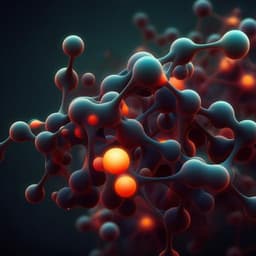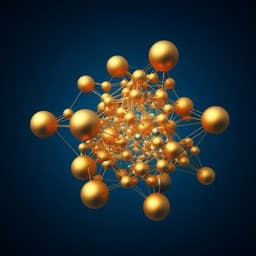
Chemistry
Dinuclear Cu(I) molecular electrocatalyst for CO₂-to-C₃ product conversion
N. Sakamoto, K. Sekizawa, et al.
Explore groundbreaking research by Naonari Sakamoto and colleagues, showcasing a novel CO₂ reduction reaction using a Br-bridged dinuclear Cu(I) complex that robustly produces C₃H₇OH. This innovative study delves into the mechanistic insights of C-C coupling, paving the way for next-generation catalysts aimed at enhancing multicarbon CO₂ reduction products.
Playback language: English
Introduction
The electrochemical carbon dioxide reduction reaction (CO₂RR) is a promising technology for storing renewable energy and creating a sustainable carbon-neutral economy. Current challenges include the structural stability of metal complex catalysts and the difficulty in synthesizing high-value-added C₃ products due to the challenges in achieving C-C coupling. While molecular metal complex catalysts offer tunability in CO₂ reduction performance through molecular design, they have limitations in stability and C-C coupling. Higher-energy density multicarbon (C₂⁺) products, such as ethylene, ethanol, and particularly C₃H₇OH, are highly desirable due to their higher energy densities and market demand. Efficient CO₂ adsorption, retention near the catalyst, multi-electron/proton transfer, and precise control over structural features related to C-C coupling are crucial for efficient CO₂ conversion. Molecular catalysts, with their structural flexibility and ability to modulate reactivity and selectivity, offer potential advantages over other catalyst types like single-metal-atom nitrogen-doped carbon and coordination polymers. While mononuclear molecular catalysts have achieved selective generation of C₁ products, C₂ product formation remains scarce, and C₃ product formation has not been reported. Multinuclear molecular catalysts are promising for C₃ formation due to their potential to facilitate the interaction and coupling of multiple CO₂ molecules. Effective CO₂ feed promotion, adsorption, and retention near the catalyst are important for C-C coupling reactions. Molecular designs incorporating amine groups or π-conjugated substituents can enhance CO₂ adsorption, but retention of reaction intermediates is also critical, and previously reported catalysts tend to decompose rapidly. This work aims to design a molecular catalyst with a robust structure and high CO₂ adsorption/retention ability to achieve C₂ product formation, focusing on Cu multinuclear metal complexes with Br bridging ligands.
Literature Review
The literature extensively covers the challenges and opportunities in electrochemical CO₂ reduction. Studies highlight the need for efficient CO₂ adsorption and retention near the catalyst, emphasizing the role of materials exhibiting adsorption-desorption hysteresis. While reversible CO₂ adsorption is surface-area dependent and has been demonstrated for various materials, molecular catalysts generally lack sufficient CO₂ retention for C-C coupling. Molecular design strategies, such as introducing amine groups or π-conjugated substituents, have been explored to improve CO₂ retention, but these enhancements alone are insufficient for C₂ product formation. The stability of molecular catalysts is a critical issue, as many reported catalysts decompose too quickly under operating conditions, negating the advantages of precise molecular design. Previous work has demonstrated the successful use of molecular catalysts for selective production of C₁ products by manipulating the electronic state of the central metal using organic ligands. However, reports of C₂ product formation using molecular catalysts are limited, and there are no prior reports of C₃ product formation. This scarcity highlights the need for innovative catalyst designs that can facilitate C-C coupling reactions and overcome the limitations of existing mononuclear systems. Multinuclear molecular catalysts are considered promising candidates for the generation of C₂ and C₃ products.
Methodology
This study involved the synthesis and characterization of di- and trinuclear Cu(I) molecular metal complexes: [Cu(µ-Br)₂(bis-methyl-bisphenylphosphine)₂]Br (CuBr-BisM), Cu₂(µ-Br)₂(1,2-phenyl-bisphenylphosphine)₂ (CuBr-12B), and Cu₂(µ-Br)₂(triphenylphosphine)₂(4-phenylpyridine)₂ (CuBr-4PP). Single-crystal X-ray diffraction analysis confirmed the structures. CO₂ adsorption-desorption behavior was investigated, revealing that CuBr-4PP exhibited hysteresis, indicating CO₂ retention, unlike the others. Cyclic voltammetry under Ar and CO₂ atmospheres was performed in acetonitrile to examine the electrochemical properties. Operando X-ray absorption near-edge structure (XANES) analysis confirmed that CuBr-4PP maintained its Cu(I) oxidation state during CO₂ electrolysis. Heterogeneous electrochemical CO₂RRs were conducted in a 0.5 M KHCO₃ electrolyte using carbon paper electrodes modified with the CuBr complexes. Faradaic efficiencies for various products (H₂, HCOOH, CO, C₂H₂OH, C₂H₄, CH₄) were determined at different potentials. Isotope tracer experiments using ¹³CO₂ identified the carbon source of the products. Operando XAFS analysis was used to monitor oxidation state changes during CO₂RR, showing that CuBr-4PP retained its Cu(I) state, unlike the others. Ex situ XPS, transmission electron microscopy, dynamic light scattering, and operando Raman measurements confirmed the structural stability of CuBr-4PP during CO₂RR. Operando Raman spectroscopy investigated ligand structural changes during the reaction, observing enhanced C=C stretching vibrations of the 4PP ligand upon electron incorporation. Operando surface-enhanced Raman scattering (SERS) spectroscopy, using Ag-plate core/SiO₂ shell nanoparticles, identified reaction intermediates. Density functional theory (DFT) calculations, using CO as the substrate, were performed to elucidate the reaction mechanism, exploring possible intermediates and their energies. This focused on the C-C coupling process, analyzing free energy changes, activation barriers, and the correspondence with the SERS spectrum. The calculations considered concerted proton-coupled electron transfer (PCET) mechanisms, providing energy differences (expressed as potentials) for each step. The analysis included examining the Mulliken charge densities of the Cu center in the intermediates to assess oxidation state changes, supporting the operando XAFS results.
Key Findings
The dinuclear Cu(I) complex, CuBr-4PP, exhibited significantly different CO₂ reduction behavior compared to the other synthesized complexes. CuBr-4PP uniquely showed CO₂ adsorption-desorption hysteresis, indicating its ability to retain CO₂ in its vicinity. Electrochemical CO₂RR experiments showed that CuBr-4PP produced C₂ products, including ethanol, with high Faradaic efficiencies (up to ~50% for C₂ products and 12% for propanol) at -2.2 V versus Ag/AgCl, exceeding the performance of CuBr-BisM and CuBr-12B, which showed minimal C₂ product formation. Operando XAFS analysis confirmed the remarkable stability of the CuBr-4PP structure during the CO₂RR, maintaining its Cu(I) oxidation state and preventing the formation of Cu metal clusters. Operando Raman and SERS analyses provided evidence for the formation of key reaction intermediates, supporting the proposed C-C coupling mechanism. DFT calculations elucidated a detailed mechanism for the CO₂ reduction process, suggesting that C-C coupling occurs through the formation of a bridging intermediate between the two Cu centers in the CuBr-4PP structure. The flexible Cu-Cu distance in this binuclear structure facilitates the stepwise addition of CO₂ and subsequent coupling of the intermediate species, leading to the formation of C₂ products. The computationally inferred reaction mechanism exhibited excellent agreement with experimental data obtained from SERS, strongly suggesting that the identified reaction pathways could readily proceed under room temperature reaction conditions with applied potentials. The study's results highlight the importance of catalyst design for efficient C-C coupling and the utility of combined experimental and theoretical approaches for understanding CO₂RR mechanisms.
Discussion
The findings demonstrate the successful synthesis of a dinuclear Cu(I) molecular catalyst, CuBr-4PP, capable of efficient C₂ and even C₃ product formation from CO₂ through C-C coupling. The superior performance of CuBr-4PP is attributed to its unique CO₂ retention ability, stable structure during electrolysis, and the specific arrangement of the Cu centers which facilitate the proposed C-C coupling mechanism. The operando XAFS and other characterization results confirm the remarkable stability of the CuBr-4PP catalyst, which is essential for achieving high catalytic performance and long-term operation. The proposed mechanism, supported by DFT calculations and operando spectroscopy, provides valuable insight into the intricate steps of C-C bond formation during CO₂RR. This study significantly advances our understanding of CO₂ reduction catalysis and demonstrates a pathway towards the development of highly efficient and robust catalysts for the selective synthesis of high-value multicarbon products from CO₂. The ability to successfully produce propanol, a valuable C₃ product, is a significant achievement in the field, demonstrating a considerable step forward in achieving higher selectivity in CO₂ reduction reactions.
Conclusion
This research successfully synthesized a dinuclear Cu(I) complex, CuBr-4PP, that acts as a robust electrocatalyst for CO₂ reduction, producing significant yields of C₂ and even C₃ products through C-C coupling. Operando spectroscopic studies combined with DFT calculations elucidated a plausible reaction mechanism involving bridging intermediates between the two Cu centers. The achievement of C-C coupling in a stable molecular catalyst represents a major advance in CO₂ reduction technology, paving the way for the design of catalysts capable of selectively producing valuable multicarbon products. Future research could explore variations in ligand design to further optimize selectivity and efficiency, targeting even longer carbon chain products. Investigation into different metal centers and bridging ligands might also reveal more effective catalyst systems.
Limitations
While this study demonstrates the effectiveness of CuBr-4PP in CO₂ reduction to C₂ and C₃ products, some limitations exist. The Faradaic efficiencies, while significant, are not yet at levels for commercial viability. Further optimization of the catalyst structure and reaction conditions might be needed to increase efficiency. The DFT calculations employed approximations and assumptions, and the true reaction mechanism may be more complex than the proposed model. The study focused on a specific electrolyte (0.5 M KHCO₃); exploring other electrolytes might reveal different product selectivities or increased efficiencies. The investigation mainly focused on the propanol formation in CORR reactions rather than CO₂RR. While the work successfully achieved C3 production, it would be valuable to explore a broader range of experimental conditions to enhance the yields of C3 products directly from CO2.
Related Publications
Explore these studies to deepen your understanding of the subject.







